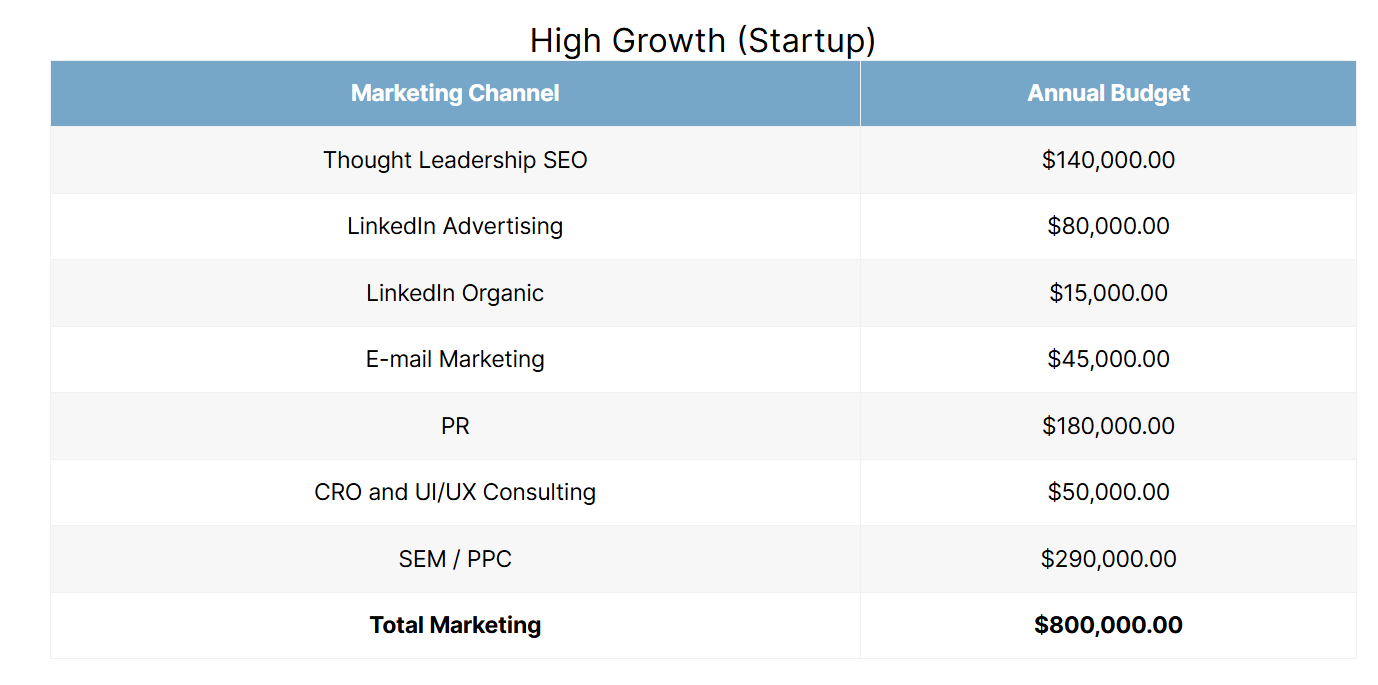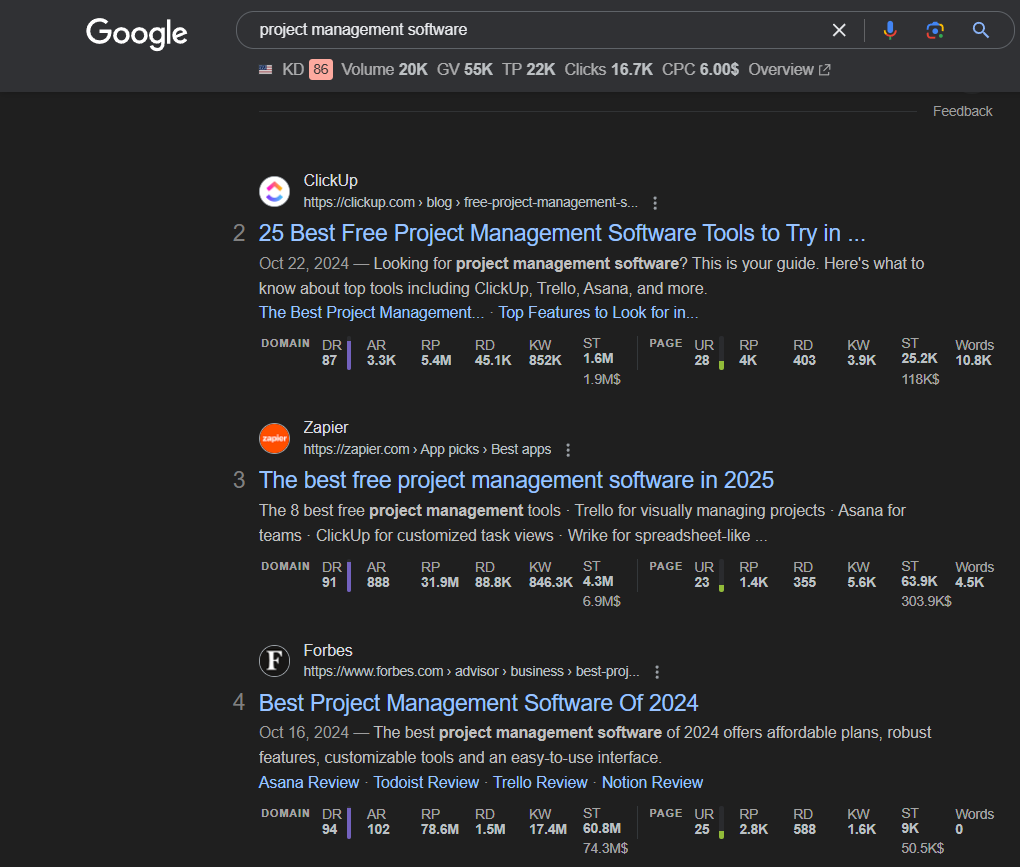TL;DR
SaaS companies should allocate roughly 5–10% of revenue to SEO—adjusting for in-house vs. agency costs, PPC spend, audience type, and competitor intensity—to fund the high-quality content, link building, and technical work needed for sustainable growth. Using keyword-based, historical, and TAM forecasting with tools like Ahrefs, Google Trends, and Search Console helps align that budget with realistic traffic and revenue goals while balancing paid and organic channels.
Are you stumped on how much to budget for SEO?
Planning SEO budgets can be tricky - set it too low, and you risk wasted spend; too high, and you might overburden your marketing efforts.
SaaS is also one of the hardest industries to rank for, with some companies spending up to 30% of their annual revenue on marketing efforts.
Not to mention that SaaS SEO is an entirely different beast than regular SEO.
It’s not like local SEO, where the majority of your work is just creating location pages.
SaaS SEO requires a much more strategic and holistic approach centered around engaging leads across the entire buyer journey.
Despite what you might find on Fiverr, SEO is rarely a cheap investment.
But when budgeted right, SEO can be one of your most efficient channels for increasing signups and demo requests.
However, you need to understand what SEO and marketing budget fits your business.
In this article, I’ll explain exactly how to structure your SaaS SEO budget and what factors to weigh before finalizing it.
Let’s jump in.
How Much Should a SaaS SEO Budget Be?
A SaaS SEO budget should typically range between 5-10% of total revenue.
Some SaaS brands targeting aggressive growth are leaning toward a 10% SEO budget allocation in 2024.
Others stick closer to a more conservative 5%.
For example, a new startup might spend more on SEO to target faster growth.
A mid-size SaaS could have more flexibility to be conservative with their SEO budget since they likely are already getting traffic from SEO.
According to Model B, early-stage SaaS companies often invest between 30% to 50% of their Annual Recurring Revenue (ARR) in marketing efforts, while more established SaaS brands may allocate 10% to 20%.

Source: First Page Sage
For most SaaS companies, regardless of stage, you’ll need an SEO budget of at least $2,500-$7,500 per month to see positive ROI from your SEO.
But, the exact amount that your business should spend on SEO depends on a few factors.
In-House Support Vs. Outsourcing to an SEO Agency
Deciding between in-house and agency support will definitely affect how much spend you should allocate to SEO.
In-house teams require budgets for salaries, tools, and ongoing training, which can quickly add up.
But it does give you greater control.
Even for an SEO specialist alone, their average salary in the US is $63,905.
That’s $5,325 per month.
And that’s excluding benefits and additional expenses.
With an agency, you’re outsourcing to a team that can completely handle your SEO at a fraction of the cost and headache of managing things internally.
On average, most SEO agencies charge around $3,209 per month.
If Paid Advertising is in the Mix
Paid advertising can also heavily influence your SEO budget.
PPC budgets tend to be ridiculously high due to the immediate results you get from investing in them.

Source: Intergrowth
Of course, investing more in paid advertising will limit how much of the marketing budget we can realistically allocate to SEO.
I’ve even seen a few cases personally where companies were spending $100,000/month on PPC while only spending $1,500 on SEO.
Even though paid had a much heavier budget, I still saw SEO outperforming those paid channels.
Their customer acquisition cost for SEO was half that of paid.
I even have a case study on this.
In most cases, if your company is investing in PPC, chances are it will be taking up the lion’s share of your SEO budget.
If Your GTM and Marketing Strategy is Set
If you feel confident with your go-to-market (GTM) strategy, then you can be more confident with your SEO budget.
Depending on your GTM strategy, you’ll have an exact idea of how much to budget for SEO.
Knowing where to spend it without leading to waste.
Which topics are specifically relevant to your product and audience.
And for startups, your funds are finite.
You can’t afford to take a spray-and-pray approach with your SEO.
But, a GTM strategy will keep you aligned on what to target.
While reducing the chance of wasted SEO spend from changing products or messaging.
I’ve seen this happen personally, and it’s devastating each time.
The Audience You’re Going After
If your audience relies heavily on search engines to find solutions, a larger SEO budget might be necessary to capture demand.
Of course, this also depends on the type of audience you’re targeting.
For example, a SaaS company targeting small-to-medium businesses (SMBs) will face different challenges than one going after enterprise clients.
SMB-focused SaaS might have a larger audience pool to target, so they will have more flexibility on the type of searches they can target.
On the flip side, a SaaS targeting enterprise accounts might need a larger SEO budget to account for the decrease in search volume and likely increase in competition.
Not to mention a larger marketing budget overall to target those enterprise accounts.
Even still, it’s worth doing some customer research before finalizing your budget.
How Aggressive Your Search Competitors Are
A big thing to consider when setting your SEO budget is how aggressive your competitors are.
If they’re all aggressively spending on SEO, you’ll have to be just as aggressive, if not more, to catch up to them.
Especially if they’ve been spending heavily on content and backlinks.
Results from SEO take time.

And you won’t overtake your competitors just by publishing 2 articles per month.
The best time to start was yesterday.
The next best time is today.
If you’re starting with a new website, you will be at a complete disadvantage against established sites.
You can overcome that disadvantage.
But be prepared to spend to do so.
How Aggressive You Want to Be With Your SEO Strategy
Lastly, your SEO budget depends on you and your company’s growth goals.
Are you looking to only grow 10-25% in the next few months?
Or aiming to triple traffic?
Your overall marketing goals will probably play the biggest part in deciding your SEO budget.
But just know: larger ambitions require larger budgets - don’t expect aggressive results with a conservative budget.
The Different Price Ranges for SEO Investments
As mentioned before, a percentage of your revenue is usually the best strategy for setting your SEO budget.
Your budget scales as you grow.
Total Revenue
Recommended SEO Budget (5%)
$100,000
$5,000
$500,000
$25,000
$1,000,000
$50,000
For a SaaS, you need to have a enough budget so you can prioritize:
- Getting high-quality links
- Building out quality content at scale
- Technical SEO, depending on your site size
Still, your overall goals play a part in determining your budget.
No matter your stage, your budget should always be aligned with your growth goals.
For startups, this means being aggressive with your SEO budget to build momentum.
For established brands, it’s about balancing SEO with other marketing strategies to achieve gradual, long-term growth.
How Does Budget Contribute to SaaS SEO?
Your budget is really your key to success for SEO.
That seems obvious.
But, it’s true.
SaaS startups with brand new domains have multiple areas they have to focus on to see success from SEO.
It’s not just “create content.”
You have to:
- Create extremely high-quality content
- Update existing content
- Build extremely high-quality links
- Make sure your site is optimized for conversions
It’s an expensive play, for sure.
So, if you’re cheap with SEO, you’re basically throwing your money into the fire.
Mid-sized companies may be able to get away with more conservative SEO budgets.
But startups don’t have that luxury.
You’re at a complete disadvantage starting out.
So, it’s really all or nothing for SEO.
Should a SaaS invest in SEO?
Almost always, yes.
Investing in SEO is worth it for most SaaS companies.
But not all.

Source: First Page Sage
Some SaaS brands might not benefit from SEO due to:
- High competition
- Poor product market fit
- Lack of resources
- Their audience not using search to purchase products
However, for most SaaS brands, SEO can build a pipeline that becomes a primary driver of growth.
It can:
- Support long sales cycles without heavy involvement
- Generate leads without heavy ad spend
- Decrease your overall customer acquisition cost and increase your customer lifetime value
- Generate long-term demand and interest in your brand
Even better, SEO gives you the flexibility to scale back your outbound efforts.
With outbound, you’re temporarily renting an audience.
For inbound and SEO, you’re building a devoted audience for your brand.
The Different Ways I Usually Forecast SaaS SEO
Forecasting is a key to SEO budgeting.
You need to know your opportunities.
And what’s realistic for you.
You can forecast your SEO in a few ways.
Keyword-Based Forecasting
This method uses search volume and CTR to estimate traffic from target keywords.
- Traffic Estimate: Estimated Monthly Traffic = Search Volume × CTR
- Leads Estimate: Estimated Leads = Traffic × Conversion Rate
- Sales Estimate: Estimated Sales = Leads × Lead-to-Sale Ratio
- Revenue Estimate: Revenue = Estimated Sales × Average Revenue Per Customer
Statistical Forecasting with Historical Data
This uses historical trends to predict future growth based on average growth rates.
- Growth Rate: Growth Rate = (Current Period - Previous Period) / Previous Period × 100
- Traffic Forecast: Projected Traffic = Current Traffic × (1 + Average Growth Rate)
TAM Analysis
This evaluates the market size and penetration rate to predict traffic potential.
- TAM: TAM = Total Audience × % Likely to Search
- Traffic Goal: Projected Traffic = TAM × Penetration Rate
These are the main formulas I’ll use when helping clients understand what their opportunities are.
And what they should budget for SEO to reach those opportunities.
Applying these Forecasts When Planning Your SEO Budget
When you plan your SEO budget, these forecasts will ultimately tell you what opportunities are available to you.
And what SEO budget will likely be necessary for you.
While using these SEO forecasts, I also recommend considering:
- Who your SEO competitors are: Who are going to be the competitors you typically go up against on the SERPs. Sometimes these aren’t even your direct competitors.
- How your decision makers usually convert: Is search the last channel they use before they make their final decision? If not, then maybe SEO might be a more difficult channel to execute.
- If it’s possible to differentiate yourself from those competitors: Are you going to be the same as everyone else or can you stand away from the crowd?
Once you have a general idea of your SEO landscape and potential, it all comes down to your level of aggression in executing your SEO strategy:
- High traffic potential, high competition: You’ll probably have to be more aggressive with your budget
- Low traffic potential, high competition: You might want to consider if SEO is worth it for your brand.
- High traffic potential, low competition: Your budget can be a bit more conservative here.
- Low traffic potential, low competition: Is the effort worth the reward here? That’s up to you to decide. There’s no right or wrong answer here.
The biggest takeaway when setting your SEO budget is to understand your landscape and how you want to approach it.
Recommended Tools for Data Gathering
There are also a few tools you can use to help gather this data.
I usually recommend using:
- Google Trends: Are there any spiking trends in that industry that might bring along search volume?
- Ahrefs or SEMrush: Track historical growth rates and search volumes. This is helpful if you don’t have access to this data via Google Search Console or Google Adwords.
- Google Search Console: Helpful for exporting first-party data based on your website. You can also use your historical CTR to predict future growth.
Why SaaS Companies Shouldn’t Be Afraid to Open Up Their Wallets for SEO
It must be funny for an SEO to tell you to spend more on SEO.
Bias aside, it’s true.
SaaS companies, especially B2B SaaS, have much longer buyer journeys and cycles compared to other industries.
Meaning:
- It takes more work to convince your ICP to convert
- Other channels have to work in tandem to nurture your audience
- You likely need a full scope of content and links to see results from SEO
Of course, this all depends on the product you have.
Some SaaS products are priced at $10/month.
While other enterprise products can go up to $5,000/month.
So, a single article isn’t enough to drive conversions.
What drives conversions is touchpoints with your brand at multiple stages of the funnel.
Whether through search, email, organic, or video.
You can’t silo SEO and expect to see results from it.
The key is content that meets users at every stage of their buyer’s journey.
While guiding them towards a conversion.
Nurturing.
This all requires budget.
And it’s generally not something you can cheap out on.
Should a SaaS Invest in Paid Search Too?
I’d encourage most marketers to balance paid ads with SEO.
While I’m inbound first, paid ads are perfect for short-term growth.
Mostly for startups.
While I don’t recommend only using paid, I do recommend finding an initial balance between SEO and PPC.
Maybe 75% PPC and 25% SEO to start out.
Then gradually decreasing it to 35% PPC and 65% SEO.
Here’s how I usually recommend most companies balance SEO and PPC:
- Start with PPC: Use PPC to generate leads and visibility while your SEO efforts ramp up. For instance, running Google Ads campaigns for high-intent keywords can provide immediate results while you build content and authority for those same keywords organically.
- Invest Simultaneously in SEO: Allocate a fair portion of your budget to SEO from the start. While PPC delivers quick wins, SEO lays the foundation for sustainable growth by targeting broader keywords and creating evergreen content.
- Scale Back PPC as SEO Grows: Once SEO becomes a consistent traffic source, you can reduce your PPC spend, focusing only on strategic campaigns like retargeting or capturing new audiences. Then, redirect the freed-up budget to expand your SEO strategy further.
Pro Tip: A SaaS company offering project management software might use PPC to bid on “best project management tools” to capture high-intent leads. Simultaneously, they can invest in SEO to rank for broader terms like “how to improve team collaboration” or “best software for remote work,” which build long-term brand authority. You
Need Help Finding the Right Budget for Your SaaS?
Want to find the perfect SEO budget for your SaaS?
Let’s make it simple.
Book a call with me to see what it will take to grow from SEO.


.png)

